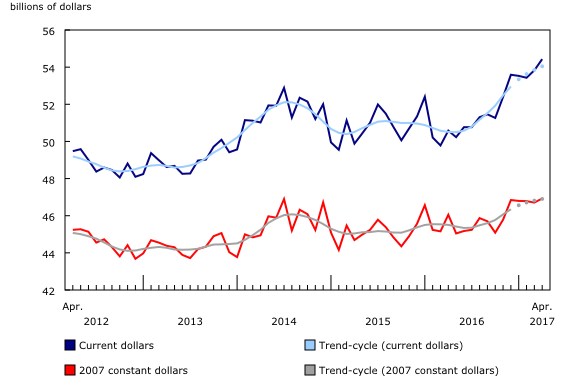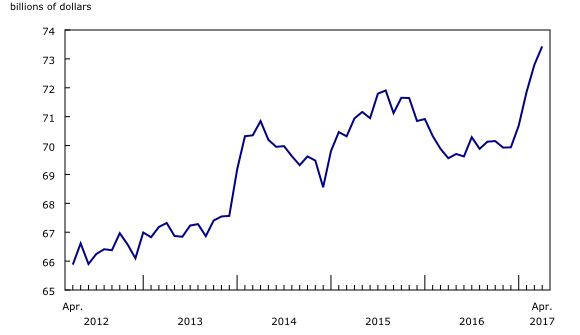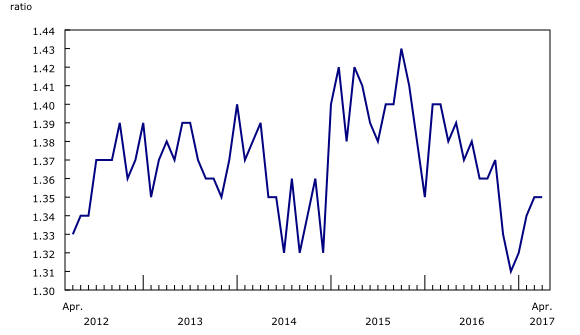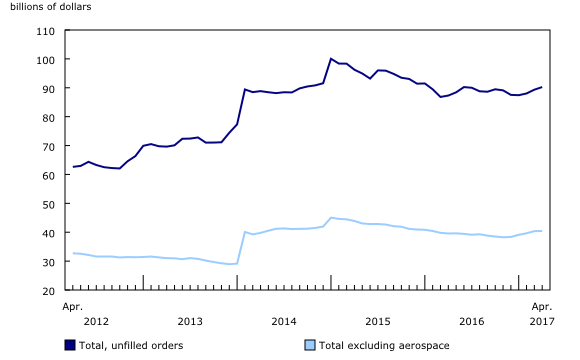Monthly Survey of Manufacturing, April 2017
Archived Content
Information identified as archived is provided for reference, research or recordkeeping purposes. It is not subject to the Government of Canada Web Standards and has not been altered or updated since it was archived. Please "contact us" to request a format other than those available.
Released: 2017-06-15
Manufacturing sales rose 1.1% to a record high $54.4 billion in April, mainly due to higher sales in the petroleum and coal product, and primary metal industries.
Sales were up in 13 of the 21 industries, representing 62% of Canadian manufacturing sales.
Once the effects of price changes are taken into consideration, manufacturing sales volumes rose 0.5% in April.
The petroleum and coal products and the primary metal industries post the largest gains
Sales in the petroleum and coal products industry rose 8.9% to $5.4 billion in April, following two months of declines. The increase reflected higher volumes and prices for petroleum and coal products. After removing the effect of price changes, sales in volume terms increased 7.8% in April.
Sales in the primary metal industry rose 3.8% to $4.2 billion, the third increase in four months. The increase in April partly reflected higher volumes and prices of primary metal products. In constant dollars, sales in the primary metal industry were up 2.5%, indicating higher volumes of products were sold.
Sales also increased in the paper (+3.5%), food (+0.5%) and machinery (+1.5%) industries. These gains were widespread and reflected higher volumes in these industries.
In contrast, sales in the transportation equipment industry decreased 1.3% to $11.0 billion. The decline was mainly attributable to the motor vehicle (-3.7%) and motor vehicle parts (-2.1%) industries, which both posted increases the previous month. Once the effects of price changes are taken into consideration, sales volumes declined by 4.7% in the motor vehicle industry and 2.9% in the motor vehicle parts industry in April.
Sales up in eight provinces
Sales were up in eight provinces in April, with Quebec and Alberta largely responsible for the total national gain, while sales were down in Saskatchewan and Manitoba.
In Quebec, sales rose 2.6% to a record high $13.0 billion in April, mainly attributable to a 10.9% gain in the transportation equipment industry. Sales also rose in the petroleum and coal products, computer and electronic product and primary metal industries.
Sales in Alberta rose for the third consecutive month, up 3.0% to $6.0 billion in April. Sales were up in 11 of 21 industries, largely driven by a 7.5% increase in the petroleum and coal products industry. Sales were also up in the machinery, food and wood product industries.
The largest monthly decrease was in Saskatchewan, where sales fell 6.0% to $1.3 billion in April. This was the third consecutive decline and was largely attributable to lower sales of non-durable goods.
Inventory levels increase
Inventory levels rose for the fifth consecutive month, up 0.9% to $73.4 billion in April. Inventories were up in 14 of 21 industries, led by the transportation equipment (+1.9%) and primary metal (+2.4%) industries. These gains were partially offset by a 2.2% decline in petroleum and coal product inventories.
The inventory-to-sales ratio was unchanged at 1.35 in April. The inventory-to-sales ratio measures the time, in months, that would be required to exhaust inventories if sales were to remain at their current level.
Unfilled orders increase
Unfilled orders rose for the third consecutive month, up 1.0% to $90.2 billion in April, reflecting a 1.7% gain in the aerospace product and parts industry to $49.8 billion. Unfilled orders in this industry represented more than half of total orders.
Unfilled orders were also up in the machinery, fabricated metal product and computer and electronic product industries.
New orders rose 0.4% to $55.3 billion, the fifth consecutive monthly gain. The increase, which was mainly attributable to more new orders in the petroleum and coal products and aerospace product and parts industries, was partially offset by fewer new orders in the motor vehicle industry.

In celebration of the country's 150th birthday, Statistics Canada is presenting snapshots from our rich statistical history.
Concrete and cement: 150 years of non-metallic mineral product sales in Canada
The knowledge of concrete, or the binding of stones in a cement mortar that can be poured into a solid strong form, was lost during the Middle Ages. Use of concrete gradually increased, particularly with the discovery of Portland cement and reinforced concrete in the 19th century.
Production in the non-metallic mineral product industries, which include concrete and cement manufacturing, reached a gross value of $3.8 million in 1870. Production increased to $9.4 million by the turn of the century, spurred in part by the building of Canada's first skyscrapers. Total shipments of non-metallic mineral products reached $116.8M in 1941 during the Second World War.
Subways construction in the 1950s and 1960s helped push total shipments of non-metallic mineral products to $1.0 billion by 1965.
Sales of non-metallic mineral products peaked at $14.4 billion in 2007, just prior to the recession, and stood at $12.9 billion in 2016.
Note to readers
Monthly data in this release are seasonally adjusted and are expressed in current dollars unless otherwise specified. For information on seasonal adjustment, see Seasonally adjusted data – Frequently asked questions.
For information on trend-cycle data, see Trend-cycle estimates – Frequently asked questions.
With this release, the Monthly Survey of Manufacturing has published real (price deflated) sales of goods manufactured for the principal manufacturing industries. The industry-level data are now available on CANSIM table 377-0009 for reference months January 2007 to April 2017.
Non-durable goods industries include food, beverage and tobacco products, textile mills, textile product mills, clothing, leather and allied products, paper, printing and related support activities, petroleum and coal products, chemicals, and plastics and rubber products.
Durable goods industries include wood products, non-metallic mineral products, primary metals, fabricated metal products, machinery, computer and electronic products, electrical equipment, appliances and components, transportation equipment, furniture and related products, and miscellaneous manufacturing.
Production-based industries
For the aerospace and shipbuilding industries, the value of production is used instead of the value of sales of goods manufactured. The value of production is calculated by adjusting monthly sales of goods manufactured by the monthly change in inventories of goods in process and finished products manufactured. The value of production is used because of the extended period of time that it normally takes to manufacture products in these industries.
Unfilled orders are a stock of orders that will contribute to future sales assuming that the orders are not cancelled.
New orders are those received, whether sold in the current month or not. New orders are measured as the sum of sales for the current month plus the change in unfilled orders from the previous month to the current month.
Manufacturers reporting in US dollars
Some Canadian manufacturers report sales, inventories and unfilled orders in US dollars. These data are then converted to Canadian dollars as part of the data production cycle.
For sales, based on the assumption that they occur throughout the month, the average monthly exchange rate for the reference month (noon spot rate) established by the Bank of Canada is used for the conversion. The monthly average exchange rate is available in CANSIM table 176-0064. Inventories and unfilled orders are reported at the end of the reference period. For most respondents, the noon spot exchange rate on the last working day of the month is used for the conversion of these variables.
However, some manufacturers choose to report their data as of a day other than the last day of the month. In these instances, the noon spot exchange rate on the day selected by the respondent is used. Note that because of exchange rate fluctuations, the noon spot exchange rate on the day selected by the respondent can differ from both the exchange rate on the last working day of the month and the monthly average exchange rate. Noon spot exchange rate data are available in CANSIM table 176-0067.
Revision policy
Each month, the Monthly Survey of Manufacturing releases preliminary data for the reference month and revised data for the three previous months. Revisions are made to reflect new information provided by respondents and updates to administrative data. Once a year, a revision project is undertaken to revise multiple years of data. During annual revisions, changes are made to seasonal adjustment parameters.
Real-time CANSIM tables
Real-time CANSIM tables 304-8014, 304-8015 and 377-8009 will be updated on June 26. For more information, consult the document Real-time CANSIM tables.
Next release
Data from the Monthly Survey of Manufacturing for May will be released on July 19.
Contact information
For more information, contact us (toll-free 1-800-263-1136; 514-283-8300; STATCAN.infostats-infostats.STATCAN@canada.ca) or Media Relations (613-951-4636; STATCAN.mediahotline-ligneinfomedias.STATCAN@canada.ca).
To enquire about the concepts, methods or data quality of this release, contact Bechir Oueriemmi (613-951-7938; bechir.oueriemmi@canada.ca) or Michael Schimpf (613-863-4480; michael.schimpf@canada.ca), Manufacturing and Wholesale Trade Division.
- Date modified:






